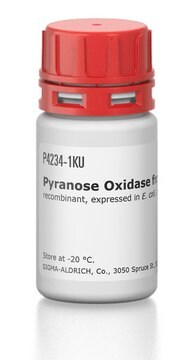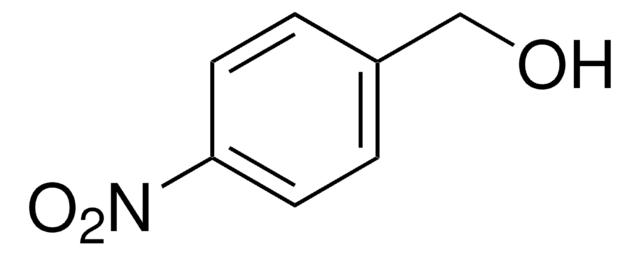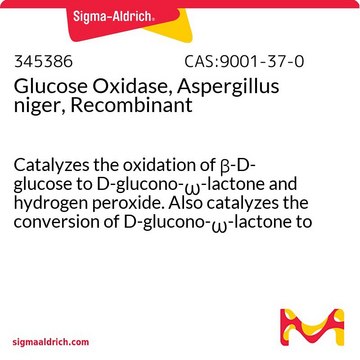P8279
Protocatechuate 3,4-Dioxygenase from Pseudomonas sp.
lyophilized powder, ≥3 units/mg solid
Iniciar sesiónpara Ver la Fijación de precios por contrato y de la organización
About This Item
Número de CAS:
Número MDL:
Código UNSPSC:
12352204
NACRES:
NA.54
Productos recomendados
origen biológico
bacterial (Pseudomonas spp.)
Nivel de calidad
Formulario
lyophilized powder
actividad específica
≥3 units/mg solid
mol peso
~700 kDa
Condiciones de envío
dry ice
temp. de almacenamiento
−20°C
Descripción general
Protocatechuate 3,4-Dioxygenase belongs to the non-heme iron family of enzymes. The active site of the enzyme contains Fe3+.
Aplicación
Protocatechuate 3,4-Dioxygenase(PCD), from Pseudomonas sp., is used for the enzymatic determination of choline esterase when coupled with phydroxybenzoate hydroxylase. It is used to improve organic fluorophore-stability in single-molecule experiments and is used to study the metabolism of protocatechuate in Rhizobiaceae.
The enzyme has been used to create an oxygen scavenging system along with protocatechuate (PCA) and Trolox. The enzyme employs a nonheme iron center that catalyzes the conversion of PCA and molecular oxygen into β-carboxy-cis,cis-muconic acid, while the antioxidant Trolox suppresses slow blinking and photobleaching of cyanine dyes. It has been used in the preparation of imaging buffer along with DMB-BSA (dynein motility buffer-BSA), ATP and protocatechuate in single molecule motility assay.
Acciones bioquímicas o fisiológicas
Protocatechuate 3,4-Dioxygenase catalyzes the degradation of 3,4-dihydroxybenzoate (protocatechuate) into β-carboxy-cis,cis-muconate.
Propiedades físicas
Structure : Protein with nonheme iron
Inhibitors : Ag+, Hg++, PCMB
Optimum pH : 9.0
Optimum temperature : 60−65°C
pH Stability : pH 7.0−9.0 (25°C, 72hr)
Thermal stability : below 50°C (pH 6.0, 1hr)
Inhibitors : Ag+, Hg++, PCMB
Optimum pH : 9.0
Optimum temperature : 60−65°C
pH Stability : pH 7.0−9.0 (25°C, 72hr)
Thermal stability : below 50°C (pH 6.0, 1hr)
Definición de unidad
One unit will oxidize 1.0 μmole of protocatechuate to 3-carboxy-cis,cis-muconate per min at pH 7.5 at 37 °C.
Forma física
Supplied as lyophilized powder.
Nota de análisis
Protein determined by biuret.
Inhibidor
Referencia del producto
Descripción
Precios
Código de clase de almacenamiento
11 - Combustible Solids
Clase de riesgo para el agua (WGK)
WGK 3
Punto de inflamabilidad (°F)
Not applicable
Punto de inflamabilidad (°C)
Not applicable
Equipo de protección personal
Eyeshields, Gloves, type N95 (US)
Elija entre una de las versiones más recientes:
¿Ya tiene este producto?
Encuentre la documentación para los productos que ha comprado recientemente en la Biblioteca de documentos.
Los clientes también vieron
Mindy I Davis et al.
Journal of the American Chemical Society, 124(4), 602-614 (2002-01-24)
The geometric and electronic structure of the high-spin ferric active site of protocatechuate 3,4-dioxygenase (3,4-PCD) has been examined by absorption (Abs), circular dichroism (CD), magnetic CD (MCD), and variable-temperature-variable-field (VTVH) MCD spectroscopies. Density functional (DFT) and INDO/S-CI molecular orbital calculations
A Buchan et al.
Applied and environmental microbiology, 67(12), 5801-5809 (2001-11-28)
Degradation of lignin-related aromatic compounds is an important ecological process in the highly productive salt marshes of the southeastern United States, yet little is known about the mediating organisms or their catabolic pathways. Here we report the diversity of a
Colin Echeverría Aitken et al.
Biophysical journal, 94(5), 1826-1835 (2007-10-09)
The application of single-molecule fluorescence techniques to complex biological systems places demands on the performance of single fluorophores. We present an enzymatic oxygen scavenging system for improved dye stability in single-molecule experiments. We compared the previously described protocatechuic acid/protocatechuate-3,4-dioxygenase system
Resonance Raman studies on protocatechuate 3, 4-dioxygenase inhibitor complexes
Que J L and Epstein R M
Biochemistry, 20(9), 2545-2549 (1981)
Brevibacterium fuscum protocatechuate 3, 4-dioxygenase. Purification, crystallization, and characterization.
Whittaker J W, et al.
The Journal of Biological Chemistry, 259(7), 4466-4475 (1984)
Nuestro equipo de científicos tiene experiencia en todas las áreas de investigación: Ciencias de la vida, Ciencia de los materiales, Síntesis química, Cromatografía, Analítica y muchas otras.
Póngase en contacto con el Servicio técnico











